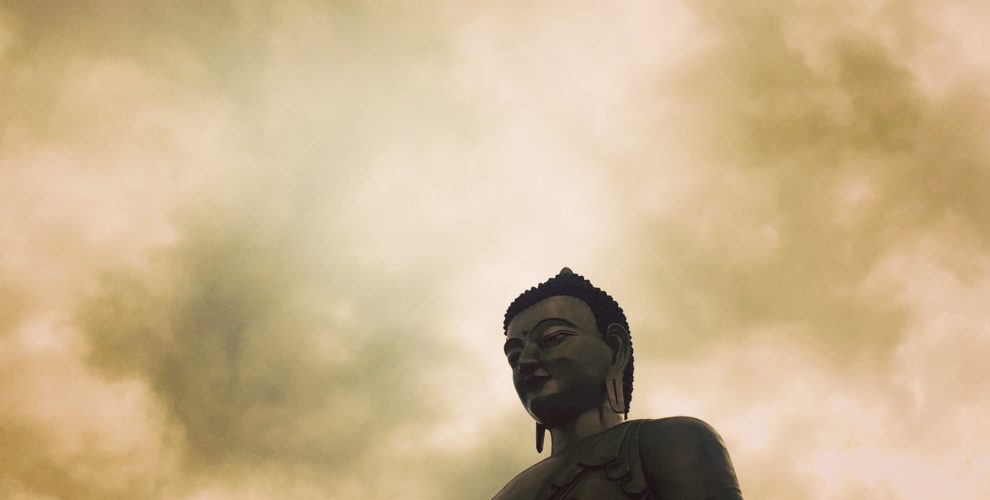The pictures of ‘Bhutan’ bring an image of a country stuck in its evolution- All the houses look ancient and alike, men still wear ‘Gho’ and the women ‘Kira’ (traditional dresses) even to office, the biggest export is electricity and the country still gets its borders protected from an alliance with the Indian army. The roads are winding in the hills with rarely a straight stretch for more than a kilometer and with the exception of Thimpu to Paro, are not well –maintained.
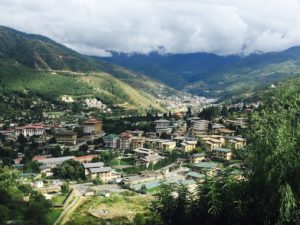 But look at the other side of it: It is a country that measures its success with a GNH (Gross National Happiness index) instead of a GDP. The King is sensible and approachable and highly respected- they recently abolished a law which allowed polygamy to the royal family. Most of their forests and rivers are still preserved and used to generate hydro-electricity. Any breach of laws is dealt with strict penalties, irrespective of the rank. Most of the people haven’t travelled anywhere beyond their country and east India, they live on their farm produce and yet are one of the happiest people in the world.
But look at the other side of it: It is a country that measures its success with a GNH (Gross National Happiness index) instead of a GDP. The King is sensible and approachable and highly respected- they recently abolished a law which allowed polygamy to the royal family. Most of their forests and rivers are still preserved and used to generate hydro-electricity. Any breach of laws is dealt with strict penalties, irrespective of the rank. Most of the people haven’t travelled anywhere beyond their country and east India, they live on their farm produce and yet are one of the happiest people in the world.
The 5 things that made me HAPPY during my travel there:
Tiger’s Nest: A search for Bhutan on Google brings images of foggy pics of this man-made wonder right in the heart of Paro- one of the prettiest and busiest cities in the country. Also known as the Taktsang monastery, this is a place on a cliff where the second Buddha is supposed to have meditated. He not only flew on a tiger to this monastery, but is also credited for bringing Buddhism to Bhutan.
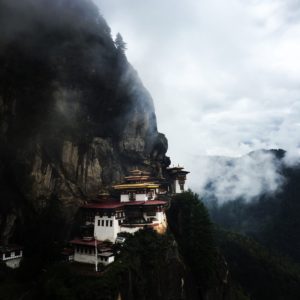
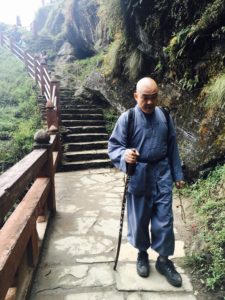
The 2-3 hour trek is arduous and best done early in the morning when the sun is not too hot and the clouds are still kissing the peaks. Half of it can be done on a horseback, but the rest has to be done on foot. We had fellow trekkers from different parts of the world. The local people even came with kids on their backs and were faster than us. The rode was flush with beautiful scenery and dense vegetation all around. There is a restaurant half way where we took a toilet break. Most of the journey the monastery is not visible and then after a particular juncture, it suddenly appeared from the clouds, bringing to view the innumerable intimidating steps to reach the cliff. A 100 meters waterfall at the entrance makes it an ethereal view.
There were school kids serving the holy food offerings at the top. The different chambers are well adorned and peaceful enough to meditate. We were lucky to observe the priests meditating and praying. A little drizzle brought some welcome relief from the steep climb and the restaurants at the bottom of the hill on the way back satiated the hunger pangs.
Football match: Though the official sport of the Bhutanese is archery, it is football that drives them crazy. We had the good fortune of watching the match between Bhutan and Bangladesh at the Chinglimithang stadium in Thimpu. Built in 1974 and refurbished in 2007, the stadium looks like an art piece straight from the history books- clearly one of the most beautiful stadiums in the world. The gallery had kids and adults cheering for their national team which won comfortably with a score of 7-1.
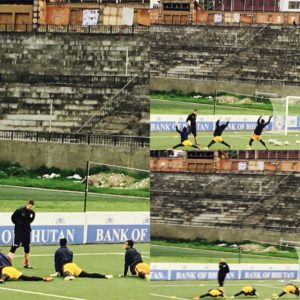

Tsechu: Bhutan has about 20 Dzongkhags (districts) governed by an administrative place called a Dzong. Most of these Dzongs are architectural masterpieces with historic stone walls and murals. Each district has an annual festival called as ‘Tsechu’ (meaning: 10 days) when the whole town gathers in their finest attire to watch the traditional dancing and revelry. We attended the Thimpu Tsechu held in the stadium at the Thimpu Dzong . The dances were long, slow and elaborate. There are a couple of ‘jokers’ who fooled around during the dances with their ‘phallic symbols’, but after an hour it got repetitive. However, the experience was unique and unprecedented; practically the whole town had assembled in one place.
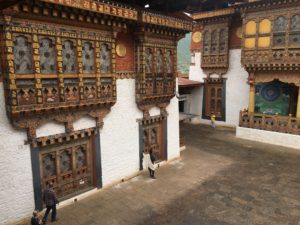
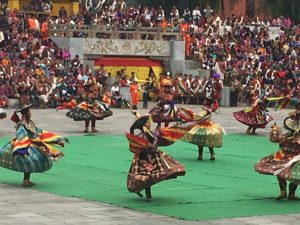
Takin: The National animal
The Zoo in Thimpu has a unique animal- Takin- who looks like a mix between a goat and a cow. Legend has it that a divine madman was having lunch and devouring a goat and a cow. He then mixed the bones of the two and commanded them to start walking – the Takin was thus born. It is a highly endangered species and cannot survive in most other habitats.
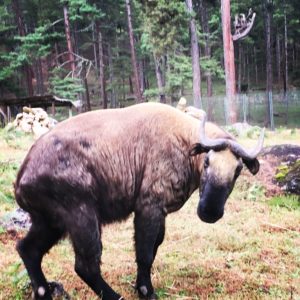
Bhutanese:
The people are mild mannered, friendly and trustworthy. The cabs are reliable and have normally fixed rates. Most of the Bhutanese we came across were proud of their tradition, government and quite knowledgeable about India and Bollywood. Since any foreign films are banned in theatres, protecting their indigenous low cost films, they get their dose of foreign films from DVDs and digital media. Their marriage laws are lenient and allow them to divorce within a week! However, their family bonding is very strong and we saw families shopping and having a good time on the weekends. Their affable and happy0go-lucky attitude makes them an amiable folk. Most of the people are dressed in their traditional attire as it is compulsory for office and schools. They speak Bhutanese and love Datshi- a national dish made of chilies and cheese.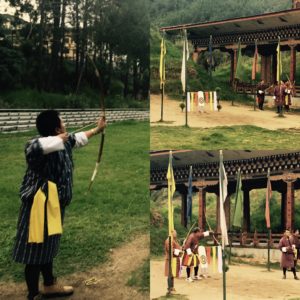
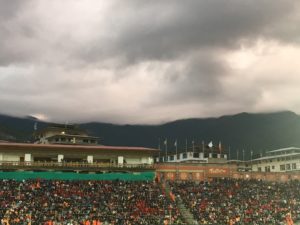
Though living there could be difficult for someone brought up in modernity, you can’t help falling in love with this country that seems to be preserved from the past.

